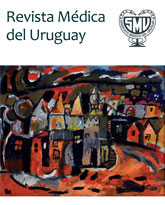Arthrogryposis multiplex congenita
An analysis of the patients seen at the Teletón Uruguay Rehabilitation Center
Abstract
Introduction: arthrogryposis multiplex congenita includes a series of heterogeneous disorders characterized by multiple joint contractures.
Objective: to describe demographic, clinical and functional characteristics of patients with amyoplasia type AMC.
Method: retrospective descriptive study conducted by reviewing the medical histories of patients with amyoplasia type AMC, who were admitted during a 5 year period. The WeeFim scale was used as an instrument to measure functional independence.
Results: 19 patients were included. They all received physiotherapy and those whose upper limbs were compromised also received occupational therapy. Ninety five percent used some kind of orthosis. Also, 95% were treated with serial casting, the majority of which were used in the lower limbs. Seventy four per cent of patients underwent orthopedic surgery. Those patients whose lower limbs were compromised were also operated on their feet. Ten (67%) out of 15 (79%) children whose lower limbs are compromised evidenced community ambulation.
Conclusions: the characteristics of 19 children were analysed. As to the AVD in children over three years old with upper limb compromise, almost all of them may eat on their own, and getting dressed above their waist is the activity they find the hardest. Thus, we point out the importance of occupational therapy. In spite of the fact that a large number of children have their lower limbs compromised, most of them achieve community ambulance. In order to do so, they need physiotherapy and most orthopedic treatments such as serial casting and/or orthopedic surgeries in the lower limbs.
References
(2) Hall JG, Aldinger KA, Tanaka KI. Amyoplasia revisited. Am J Med Genet A 2014; 164A(3):700-30.
(3) Macías Merlo L, Fagoaga Mata J. Fisioterapia en pediatría. Madrid: McGraw-Hill/Interamericana, 2002:235-51.
(4) Forin V. Artrogriposis. EMC Apar Locomot 2010; 43(2):1-9.
(5) Hoff JM, Loane M, Gilhus NE, Rasmussen S, Daltveit AK. Arthrogryposis multiplexa congenita: an epidemiologic study of nearly 9 million births in 24 EUROCAT registers. Eur J Obstet Gynecol Reprod Biol 2011; 159(2):347-50.
(6) Lamprópulos M, Puigdevall M. Artrogrifosis múltiple congénita. Rev Asoc Argent Ortop Traumatol 2004; 69(1): 79-87. Disponible en: http://www.aaot.org.ar/revista/2004/ n1_vol69/art13.pdf. Consulta: mayo 2012.
(7) Bamshad M, Van Heest AE, Pleasure D. Arthrogryposis: a review and update. J Bone Joint Surg Am 2009; 91(Suppl 4):40-6.
(8) 8. Tachdjian M. Ortopedia clínica pediátrica: diagnóstico y tratamiento. Buenos Aires: Panamericana, 1999:449-51.
(9) Gordon N. Arthrogryposis multiplex congenita. Brain Dev 1998; 20(7):507-11.
(10) De Olivera MC, Teixeira E, Sauron FN, Santos L Silva Borges. Terapia ocupacional na rehabilitação física. São Paulo: Roca, 2003: 471-281.
(11) Sells JM, Jaffe KM, Hall JG. Amyoplasia, the most common type of arthrogryposis: the potential for good outcome. Pediatrics 1996; 97(2):225-31.

This work is licensed under a Creative Commons Attribution-NonCommercial 4.0 International License.













